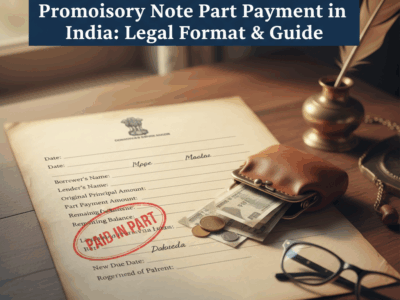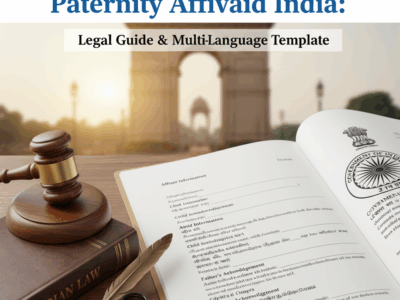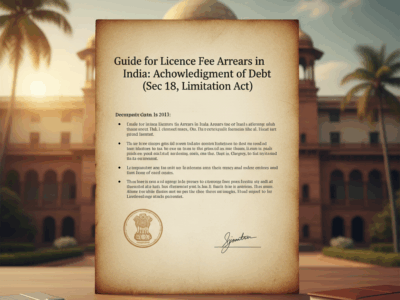In the complex landscape of debt recovery in India, the clock is always ticking. The Limitation Act, 1963, provides a crucial shield for debtors against old claims, rendering them “time-barred” after a specific period. However, this shield can be shattered by a single, powerful tool: the Acknowledgment of Debt.
This comprehensive guide delves deep into Section 18 of the Limitation Act, exploring how a simple written acknowledgment can restart the limitation period, turning a non-enforceable debt into a recoverable asset. Whether you are a creditor seeking to secure your dues or a debtor navigating financial obligations, understanding the legal nuances, drafting requirements, and strategic consequences of an acknowledgment is critical.
We will cover everything from practical templates and common pitfalls to advanced interpretations involving the Insolvency and Bankruptcy Code (IBC) and balance sheet entries.
The Legal Eagle's Guide
Last Updated: October 14, 2025
A Comprehensive Guide to Acknowledgment of Debt
Navigating Section 18 of the Indian Limitation Act, 1963
Part I: The Legal Foundation of Acknowledgment of Debt
The Principle of Limitation in Debt Recovery
The Indian Limitation Act, 1963, is the bedrock of debt recovery law in India. It prescribes a time limit, typically three years for most civil suits, within which a creditor must sue to recover a debt. This principle is rooted in two key legal maxims:
Interest Republicae ut sit finis litium (It is in the interest of the state that there should be an end to litigation).
Vigilantibus non dormientibus jura subveniunt (The law assists the vigilant, not those who sleep on their rights).
If a creditor fails to act within this period, their legal remedy becomes "time-barred." The debt still exists, but the courts can no longer be used to enforce its recovery. The law of limitation acts as a shield for the debtor against old claims. However, a written acknowledgment of the debt by the debtor turns this shield into a sword for the creditor.
Limitation: A Debtor's Shield, A Creditor's Sword
The Debtor's Shield
The Limitation Act protects debtors from stale, decades-old claims where evidence may be lost.
The Creditor's Sword
An "Acknowledgment of Debt" by the debtor provides fresh evidence, restarting the limitation period.
Dissecting Section 18 of the Limitation Act, 1963
Section 18 is the heart of this legal mechanism. It states that if a debtor makes a written, signed acknowledgment of liability *before* the original limitation period expires, a fresh period of limitation begins from the date of the signature.
The Three Pillars of a Valid Acknowledgment
Within Time
Must be made *before* the original limitation period expires.
In Writing & Signed
Verbal promises are not enough. It must be written and signed by the debtor.
Clear Admission
The language must clearly admit a present, subsisting liability.
Interactive: How Acknowledgment Resets the Clock
Visualize the impact of an acknowledgment on a standard 3-year limitation period.
Part II: Drafting a Legally Sound Acknowledgment
Essential Clauses for a Robust Document
A well-drafted acknowledgment should be clear, comprehensive, and leave no room for ambiguity. While a simple letter can suffice, a robust document should include these key clauses:
- Clear Title: "Acknowledgment of Debt" or "Acknowledgment of Liability".
- Party Details: Full legal names and addresses of both Debtor and Creditor.
- Reference to Original Debt: Mention the original loan agreement, invoice numbers, etc.
- Unambiguous Acknowledgment: A clear, direct, and unconditional admission of the debt.
- Amount Due: Specify the exact principal and interest in figures and words.
- Execution: Signature of the debtor or an authorized signatory, with date and place.
Common Drafting Pitfalls to Avoid
Drafting Do's and Don'ts
| Requirement | ✔️ Legally Robust | ❌ Legally Risky |
|---|---|---|
| Timing | Signed *before* the limitation period expires. | Signed *after* the limitation period has lapsed. |
| Clarity | "I acknowledge that I am liable to pay Rs. X." | "This is without prejudice to my rights." |
| Scope | Acknowledges the full debt amount claimed. | Acknowledges only a part of the debt. |
| Execution | Signed by debtor or duly authorized agent. | Signed by an unauthorized employee. |
Part III: Legal Format: A Practical Template
While the specific wording can vary, a formal Acknowledgment of Debt often follows a clear and direct structure. Below is a sample legal format based on common practice. This template can be adapted for various situations, but it is crucial to have it reviewed by a legal professional before use.
[Date]
From:
[Full Name of Debtor]
[Address of Debtor]
To:
[Full Name of Creditor]
[Address of Creditor]
Subject: Acknowledgment of Debt pertaining to [Original Agreement/Invoice Details]
Dear Sir/Madam,
This is with reference to the outstanding amount of Rs. [Amount in Figures]/- (Rupees [Amount in Words]) due from me/us on account of the [Loan Agreement / Promissory Note / Bond / Invoice No.] dated [Date of Original Document].
I/We hereby acknowledge and confirm that I am/we are legally liable to you for the aforementioned amount.
I/We request you to kindly grant an extension for the repayment. I/we propose to clear the entire outstanding amount within a period of [Number] months from the date of this letter.
This acknowledgment is given to you to extend the period of limitation as per Section 18 of the Limitation Act, 1963.
Thank you for your understanding.
Yours faithfully,
_________________________
(Signature of Debtor)
[Full Name of Debtor]
[तारीख]
प्रेषक:
[देनदार का पूरा नाम]
[देनदार का पता]
प्रति:
[लेनदार का पूरा नाम]
[लेनदार का पता]
विषय: [मूल समझौते/चालान विवरण] से संबंधित ऋण की स्वीकृति
महोदय/महोदया,
यह पत्र [मूल दस्तावेज़ की तारीख] को निष्पादित [ऋण समझौते / वचन पत्र / बॉन्ड / चालान संख्या] के कारण मुझ पर/हम पर बकाया रु [अंकों में राशि]/- (रुपये [शब्दों में राशि]) के संदर्भ में है।
मैं/हम एतद्द्वारा स्वीकार करता/करते हूँ/हैं और पुष्टि करता/करते हूँ/हैं कि मैं/हम उपरोक्त राशि के लिए आपके प्रति कानूनी रूप से उत्तरदायी हूँ/हैं।
मैं/हम आपसे अनुरोध करता/करते हूँ/हैं कि कृपया पुनर्भुगतान के लिए विस्तार प्रदान करें। मैं/हम इस पत्र की तारीख से [संख्या] महीनों की अवधि के भीतर पूरी बकाया राशि का भुगतान करने का प्रस्ताव करता/करते हूँ/हैं।
यह स्वीकृति आपको परिसीमा अधिनियम, 1963 की धारा 18 के अनुसार परिसीमा की अवधि बढ़ाने के लिए दी गई है।
आपकी समझ के लिए धन्यवाद।
भवदीय,
_________________________
(देनदार का हस्ताक्षर)
[देनदार का पूरा नाम]
[তারিখ]
প্রেরক:
[ঋণগ্রহীতার পুরো নাম]
[ঋণগ্রহীতার ঠিকানা]
প্রাপক:
[ঋণদাতার পুরো নাম]
[ঋণদাতার ঠিকানা]
বিষয়: [মূল চুক্তি/চালানের বিবরণ] সম্পর্কিত ঋণের স্বীকৃতি
মহাশয়/মহাশয়া,
এই চিঠিটি [মূল দলিলের তারিখ]-এর [ঋণ চুক্তি / প্রমিসরি নোট / বন্ড / চালান নং]-এর কারণে আমার/আমাদের উপর বকেয়া থাকা [অঙ্কে টাকার পরিমাণ]/- টাকা (কথায় [কথায় টাকার পরিমাণ]) প্রসঙ্গে।
আমি/আমরা এতদ্বারা স্বীকার করছি এবং নিশ্চিত করছি যে আমি/আমরা উল্লিখিত অর্থের জন্য আপনার কাছে আইনত দায়বদ্ধ।
আমি/আমরা আপনাকে অনুরোধ করছি দয়া করে পরিশোধের জন্য সময়সীমা বাড়ানোর। আমি/আমরা এই চিঠির তারিখ থেকে [সংখ্যা] মাসের মধ্যে সম্পূর্ণ বকেয়া অর্থ পরিশোধ করার প্রস্তাব দিচ্ছি।
এই স্বীকৃতি আপনাকে পরিसीमा আইন, ১৯৬৩-এর ধারা ১৮ অনুযায়ী পরিसीमा সময়কাল বাড়ানোর জন্য দেওয়া হয়েছে।
আপনার সহযোগিতার জন্য ধন্যবাদ।
বিনীত,
_________________________
(ঋণগ্রহীতার স্বাক্ষর)
[ঋণগ্রহীতার পুরো নাম]
Note: The inclusion of a repayment proposal is optional but common. The core of the document is the unequivocal acknowledgment of liability, which is essential for it to be valid under Section 18.
Part IV: Advanced Legal Nuances & Interpretations
Beyond the basics, several complex legal questions arise in the application of Section 18. Understanding these nuances is key to leveraging the law effectively.
Implied vs. Express Acknowledgment
An acknowledgment does not need to use the words "I acknowledge the debt." The admission of liability can be implied from the language used. For instance, a letter from a debtor stating, "I am unable to pay the sum you have demanded right now, but I will arrange for it in six months," can be interpreted by a court as an implied acknowledgment of the underlying liability. The key is whether the statement, taken as a whole, amounts to an admission.
The Role of a "Duly Authorized Agent"
Section 18 allows an acknowledgment to be signed by the party or "by an agent duly authorised in this behalf." This is crucial in corporate settings. Who is a "duly authorised agent"?
- Company Directors/Partners: Generally have the authority to bind the company/firm.
- Chartered Accountants/Lawyers: May be considered authorized if they have specific instructions to communicate with the creditor regarding the debt.
- Accounts Staff: An accountant sending a balance confirmation email may bind the company, depending on their role and the context of the communication.
A signature by a person with no authority (e.g., a junior employee) will not be a valid acknowledgment. The burden of proof is on the creditor to show the agent had authority.
Acknowledgment and the Insolvency & Bankruptcy Code (IBC), 2016
The interplay between the Limitation Act and the IBC is a critical area of modern commercial law. For an operational or financial creditor to initiate insolvency proceedings, the debt must not be time-barred.
An acknowledgment of debt (like an entry in a balance sheet or an OTS offer) can reset the limitation period, making an old debt "live" again for the purpose of filing an IBC application. This has significant implications for corporate debtors.
IBC & Limitation: The Acknowledgment Pathway
A corporate debt's 3-year limitation period is about to expire.
The corporate debtor shows the debt in its audited balance sheet (a valid acknowledgment).
A fresh 3-year limitation period starts from the date of the balance sheet's signature.
The creditor can now initiate an IBC proceeding based on this revived debt.
Stamping and Evidentiary Value
A pure acknowledgment of debt under Section 18 does not require stamping under the Indian Stamp Act, 1899, to be admissible as evidence. However, if the document contains a promise to pay, it may be construed as a promissory note, which has specific stamp duty requirements. This is a fine but critical distinction.
V. Use Cases and Practical Applications
The Acknowledgment of Debt is a versatile tool used across various financial dealings. Use the filters below to explore scenarios relevant to you.
Personal Lending Scenarios
In informal loans between friends or family, a simple written note, email, or even a text message admitting the loan can serve as a valid acknowledgment. This simple act transforms an informal promise into a legally enforceable debt for a fresh period of three years.
Commercial and Business Transactions
Acknowledgments often happen unintentionally in business. An email from an accounts department confirming an outstanding balance or a signed account reconciliation statement can restart the limitation period, even for disputed invoices. This highlights the risk of "inadvertent acknowledgment."
Balance Sheet Acknowledgment: The Bishal Jaiswal Test
The Supreme Court has clarified that an entry of debt in a company's balance sheet can be a valid acknowledgment. However, it's not absolute. It must be read along with the Directors' and Auditor's Reports.
The Supreme Court's Flowchart
Debt shown in Balance Sheet
Review Directors' & Auditor's Reports
Is the liability disputed in the reports?
The "OTS Trap" in Settlement Negotiations
A One-Time Settlement (OTS) offer from a debtor, made in writing, is a classic acknowledgment. If the creditor rejects the settlement offer, they can still use the offer letter itself as evidence to restart the limitation period for the *entire original debt*. This is a significant strategic risk for debtors.
VI. Legal Consequences and Strategic Considerations
The decision to sign an acknowledgment carries significant weight. For a creditor, it's a vital tool; for a debtor, it's a waiver of a powerful legal defense.
Acknowledgment vs. A Promise to Pay a Time-Barred Debt
| Aspect | Acknowledgment (Sec. 18, Limitation Act) | Promise to Pay (Sec. 25(3), Contract Act) |
|---|---|---|
| Applicability | Applies to a subsisting, legally enforceable debt. | Applies to a debt that is already time-barred. |
| Timing | Must be made *before* the limitation period expires. | Can be made any time *after* the debt is time-barred. |
| Legal Effect | Extends the time limit to enforce the *original* debt. | Creates a *new, valid, and enforceable contract*. |
VII. Frequently Asked Questions (FAQ)
What if the acknowledgment doesn't specify the exact amount?
It is not essential for the acknowledgment to specify the exact amount. It is sufficient if the acknowledgment relates to a present subsisting liability. The creditor can prove the exact amount through other evidence. However, if the acknowledgment is for a specific, lesser amount, it may only extend the limitation for that part of the debt.
How is Section 18 different from Section 19 (Effect of part-payment)?
Both extend the limitation period, but they operate differently. Section 18 requires a written, signed acknowledgment of liability. Section 19 deals with the effect of part-payment of the principal or payment of interest. For Section 19 to apply, the payment must be made by the debtor, and there must be evidence (in the debtor's handwriting or a signed writing) that the payment was made. A simple bank transfer without accompanying documentation may not be enough to satisfy Section 19.
Can an acknowledgment in a modern format like email or WhatsApp be valid?
Yes. Indian courts have progressively accepted electronic communication as valid evidence, provided it meets the requirements of the Information Technology Act, 2000. An email or WhatsApp message that is in writing, contains a clear admission of debt, and can be attributed to the debtor (e.g., sent from their known email ID or phone number) can be considered a valid acknowledgment under Section 18.
Can an acknowledgment made under coercion or fraud be challenged?
Absolutely. Like any contract or admission, an acknowledgment of debt can be challenged in court if the debtor can prove it was obtained through coercion, undue influence, fraud, or misrepresentation. The burden of proving such claims would lie heavily on the debtor.
VIII. Concluding Recommendations
For Creditors
- Proactively track limitation periods for all receivables.
- Use legally robust templates for acknowledgments.
- Preserve all written communications from debtors, including emails and messages.
- Conduct deep due diligence on corporate balance sheets before limitation expires.
For Debtors
- Train finance staff on the legal risks of routine communication.
- Seek legal counsel before making any settlement offers (OTS).
- Do not rely solely on the term "without prejudice"; your actions matter more.
- Use strategic caveats and disclosures in financial reports for disputed liabilities.







